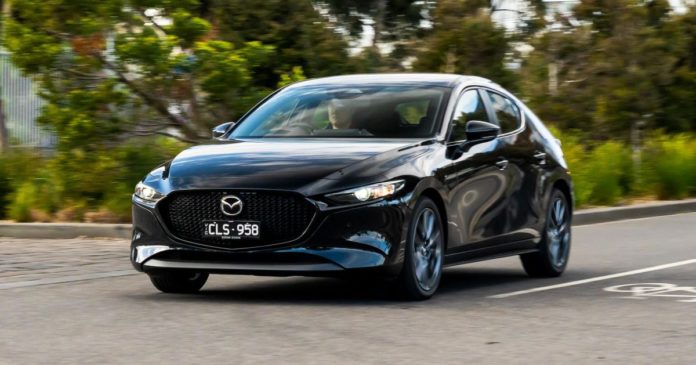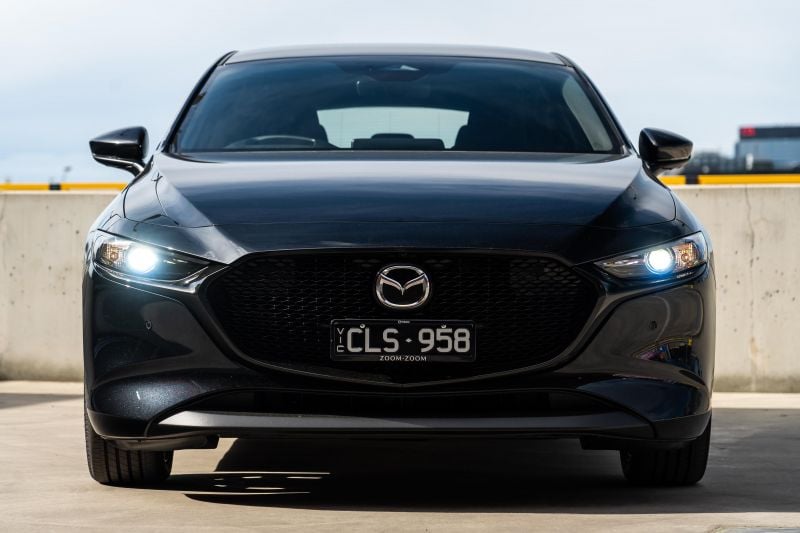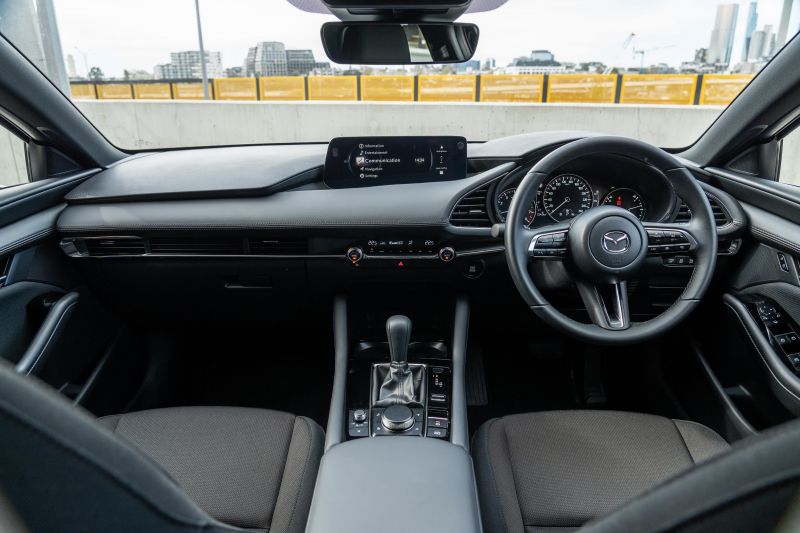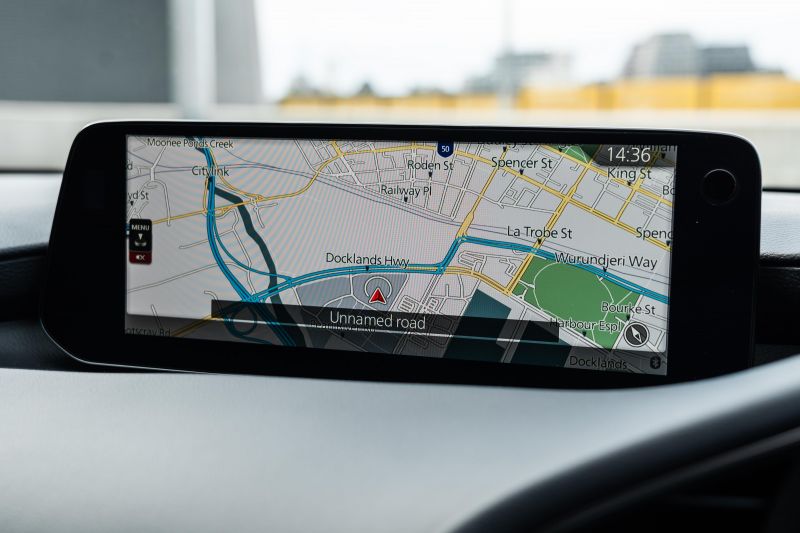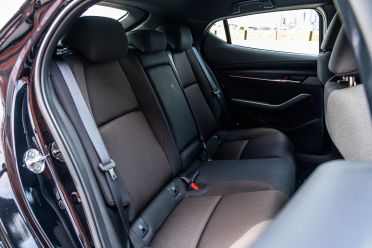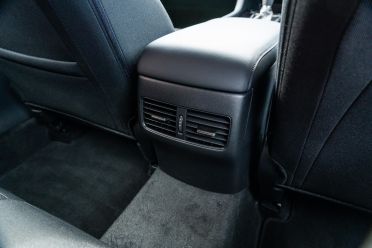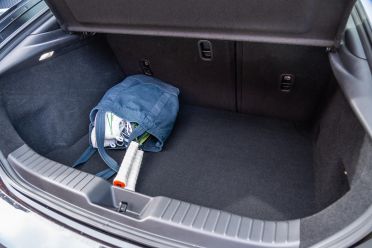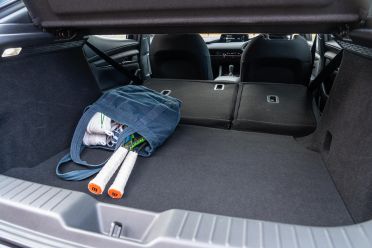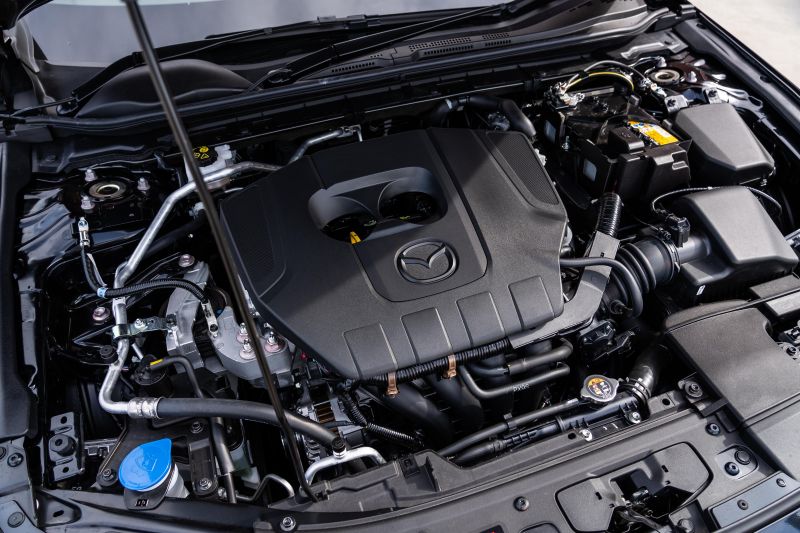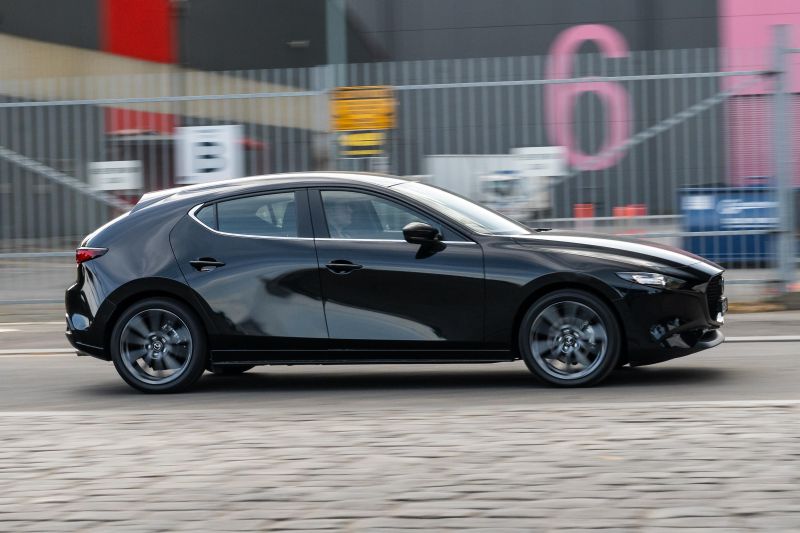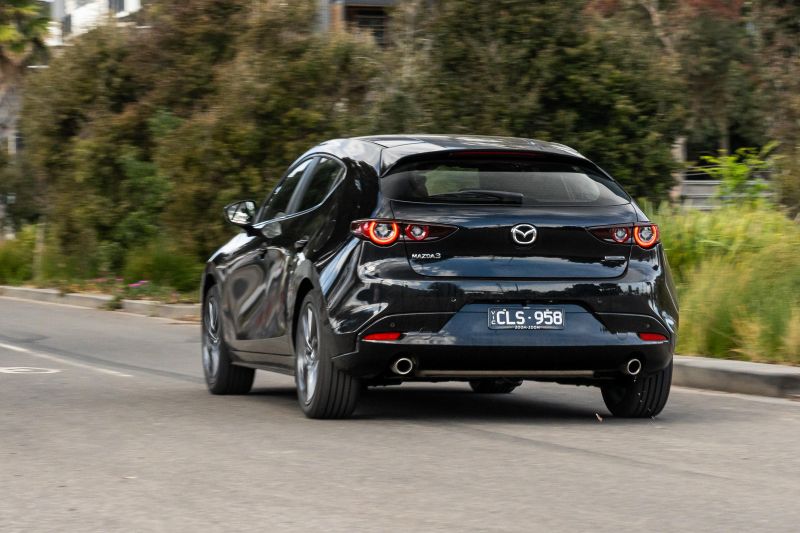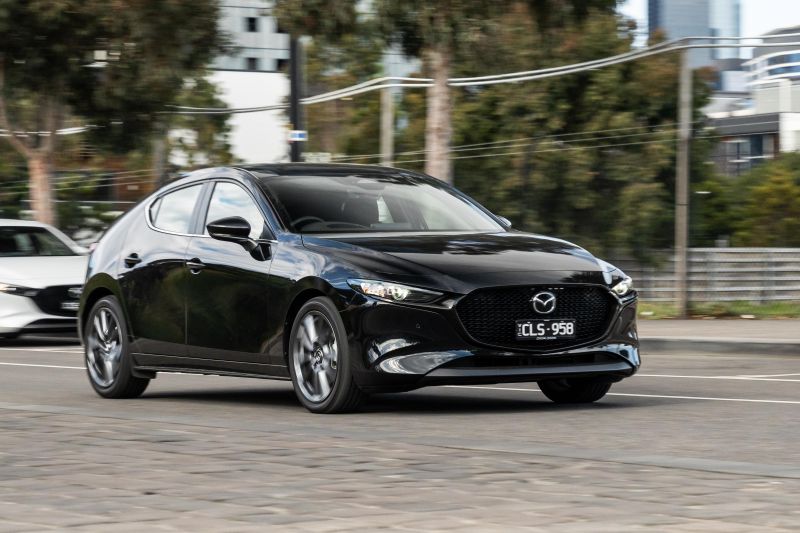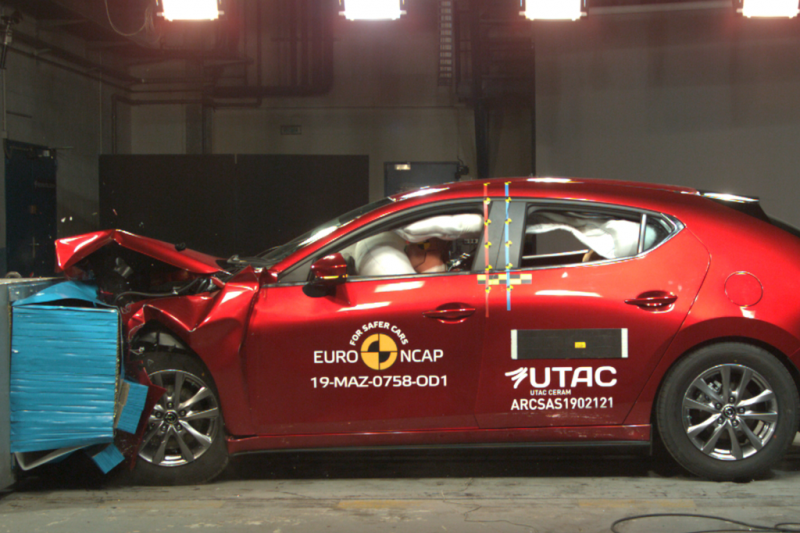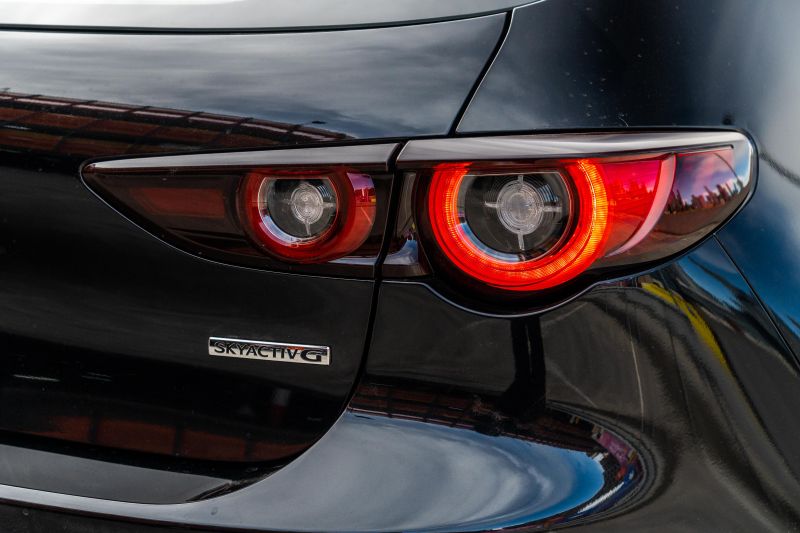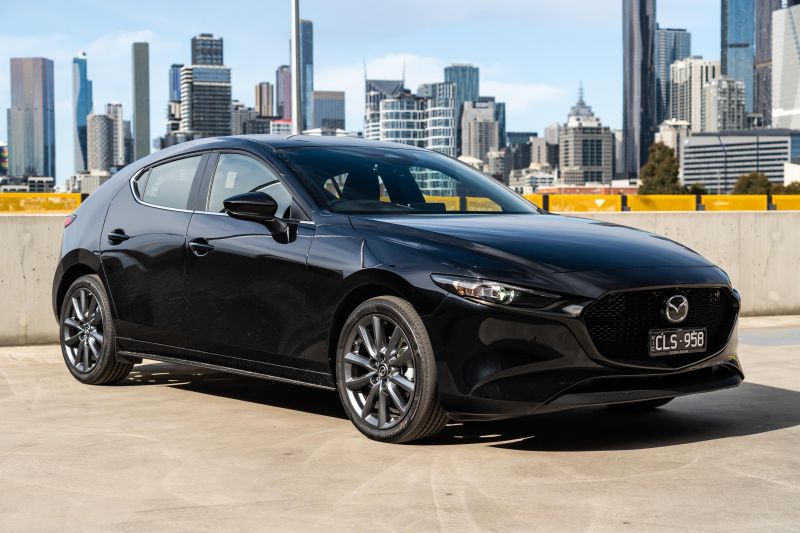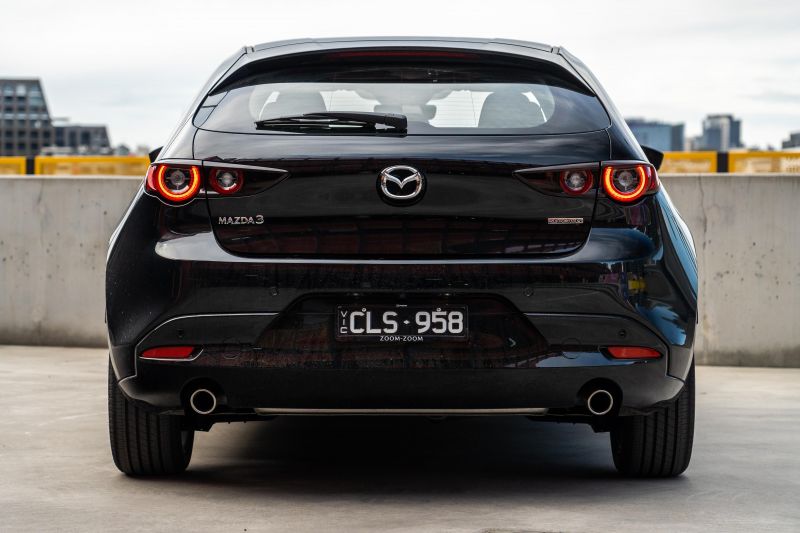It’s still a common sight on Australian roads, but the Mazda 3 isn’t the sales favourite it once was.
The Japanese small car was Australia’s top-selling nameplate once upon a time, and remained a segment leader even once the SUV craze took hold. In 2024 however, it doesn’t even make the Top 20 list.
But that’s not to say it’s because the Mazda 3 is falling behind the pack. If anything it’s still one of the best small cars you can buy, especially as numerous rival brands withdraw their small passenger car nameplates in Australia.
This fourth-generation Mazda 3 first launched in 2019, and has received numerous running changes since but no major facelift or redesign. In my eyes, it’s still one of the best-looking small cars on sale.
Here on test we have the 2024 Mazda 3 G20 Evolve Hatch, the one-up from base hatchback model that can be parked in your driveway for a little over $36,000.
Mazda rolled out some running changes last year as part of an MY24 update, including a larger infotainment display with wireless Apple CarPlay and Android Auto, the discontinuation of manual and mild-hybrid variants, while the ‘G20’ 2.0-litre petrol engine received a fuel-saving cylinder deactivation function.
How does it fare in today’s super competitive market? Read on to find out.
How does the Mazda 3 fare vs its competitors?
View a detailed breakdown of the Mazda 3 against similarly sized vehicles.

Mazda
Mazda 3
How much does the Mazda 3 cost?
Prices rose for last year’s update by up to $2310, but have remained the same since.
It’s worth noting the Mazda 3 is available as both a hatchback and a sedan, with no price discrepancy between body styles.
Prior to this update, the six-speed automatic commanded a $1000 premium over the now discontinued six-speed manual transmission.
2024 Mazda 3 pricing:
- Mazda 3 G20 Pure: $30,320
- Mazda 3 G20 Evolve: $31,870
- Mazda 3 G20 Touring: $34,520
- Mazda 3 G25 Evolve SP: $34,520
- Mazda 3 G25 GT: $38,420
- Mazda 3 G25 Astina: $42,320
Prices exclude on-road costs
See how the Mazda 3 shapes up against its rivals using our comparison tool.
What is the Mazda 3 like on the inside?
Pretty much the same as it has been since this generation launched, but there’s a larger screen now.
Even as newer rivals have arrived, the now mature-aged Mazda 3 continues to be a benchmark for compact interiors.
From the high ratio of soft-touch materials, stitched leatherette accents, and overall clean design, the Mazda’s cockpit could be mistaken for a premium-branded model if you covered up the badge on the steering wheel.
It’s a very minimalist cabin, with a lot of clean lines and a pared back approach to physical switchgear – though there are still actual knobs and buttons for the climate control, volume and the like.
The steering wheel is another tactile highlight. The classic rounded design with a thin centre hub and clicky buttons looks and feels lovely in the hand, while the grooves and cutouts for your hand feel well thought out.
Comfort up front is likewise very good, with supportive seats that, while manually adjustable, have angle adjustment for the thigh cushion. It’s pretty easy to find the perfect driving position.
Mazda hasn’t rolled out its new digital instrument cluster beyond the Large Architecture range (CX-60, CX-90), though the 3’s 8.0-inch part-digital cluster is a nice balance of new-school meets old-school.
Both the instrument binnacle and Mazda Connect infotainment display offer a minimalist design with beautifully clean fonts, which make for a very classic look. It’s all very easy to read and navigate, too.
You can toggle a couple of different views on the driver’s display too, including a conventional virtual dial with needle, a minimalist driver assistance display, a speedometer with central trip computer. I like the classic one, personally.
Our test car’s optional Vision Technology Pack not only brings more assistance and safety systems, but also a larger 10.25-inch infotainment display – up from 8.8-inch.
While the larger display makes everything a little bigger and clearer, there’s little other differentiation from the smaller Mazda Connect system. You also don’t get wireless Apple CarPlay and Android Auto in this spec, which is frustrating given the same unit in the Touring and above do (plus a wireless phone charger).
The Mazda Connect interface comes with embedded satellite navigation, DAB radio, and wired smartphone mirroring. It all works as you’d expect.
An increasing amount of rivals are adding connected services to their infotainment systems, which the Mazda currently lacks. Given the Japanese brand is rolling out telematics and connected services this year starting with the MX-5 sports car, we wouldn’t be surprised if that’s the next model-year change for the 3.
Things are perhaps a little less rosy in the rear, especially in the Mazda 3 hatch. The fastback-style roofline and pinched glasshouse mean it’s quite a dark place to sit, and if you’re taller that sloping roofline eats into headroom.
At 6’1 I can squeeze in behind my own driving position with limited knee room and legroom. My VW Golf is far better equipped for people carrying, for example, let alone newer rivals in the segment like the Kia Cerato and Skoda Scala.
Stepping up to the Evolve over the Pure gets you rear air vents and a fold-down centre armrest, which makes the second row a lot more liveable should you need to carry people in the second row.
Other amenities include a map pocket behind the front passenger’s seat (not the driver), bottle holders in the doors, and the requisite child seat anchor points (i.e. ISOFIX and top-tethers).
Arguably the 3 Hatch’s biggest weak spot is the boot, which is among the smallest in class. It offers just 295 litres of capacity with the second row upright – Mazda doesn’t quote a two-seat figure, either.
There’s a steel temporary space saver spare wheel under the boot floor of every Mazda 3.
What’s under the bonnet?
| Model | Mazda 3 Skyactiv-G 2.0 |
|---|---|
| Engine | 2.0L 4cyl petrol |
| Power | 114kW (6000rpm) |
| Torque | 200Nm (4000rpm) |
| Transmission | 6-speed auto |
| Driven wheels | Front-wheel drive |
| Weight | 1414kg |
| Fuel economy (claim) | 5.9L/100km |
| Fuel economy (observed) | 7.7L/100km |
| Fuel tank size | 51 litres |
| Fuel requirement | 91 RON |
See how the Mazda 3 shapes up against its rivals using our comparison tool.
How does the Mazda 3 drive?
The Mazda 3 really embodies the brand’s zoom zoom driving philosophy.
Even with the base 2.0-litre petrol engine, the Mazda 3 offers willing performance and engaging dynamics that make even the daily grind a fun time behind the wheel.
There’s a really nice directness and responsiveness to all of the driver controls, though it’s not so connected or unassisted that everyday driving scenarios a chore. If anything, it’s quite the opposite.
I love the buttery fluid steering, and the wonderfully balanced ride that allows for playful and natural body roll in corners to tie in with the keen front end, while also doing a good job at ironing out the lumps and bumps of city driving.
There was a bit of hullabaloo about the 3’s switch from a multilink rear suspension to a torsion beam setup for this generation, and while the hatch in particular can be a little stiff at the rear over harsher imperfections it’s far from uncomfortable and is sort of in keeping with the 3 Hatch’s more athletic and fun focus.
Some may pan the Skyactiv-G 2.0’s meek on-paper outputs as being ‘underdone’, and while its straight-line pace won’t knock your socks off, the revvy petrol engine and six-speed auto make for decent progress.
In normal driving it’s more than adequate, with great naturally aspirated response and snappy shifts, though if you need to gun it you’ll feel it run out of puff at the top end. For most people though, it’s perfectly fine.
There’s a more powerful and more expensive 2.5-litre engine available higher in the range, nearly $3000 dearer in its cheapest form. Said G25 Evolve SP adds a bit more kit too, including keyless entry, a powered driver’s seat and wireless smartphone mirroring, amongst other items – it could well be the sweet spot in the range.
If you like a bit more grunt under your right foot, it could be something to consider.
But should you spend most of your time commuting around the city and the suburbs, you probably won’t need more than what the 2.0-litre offers. Plus, you’re likely to spend less on fuel if you go for the smaller engine.
We saw an indicated return of 7.7 litres per 100km in mixed conditions favouring high-traffic peak-hour commuting, which while up on Mazda’s combined claim 5.9L/100km isn’t a world away from the urban claim of 7.3L/100km.
That said, something like a Volkswagen Golf 110TSI will use a litre or two less, and that gap widens further if you’re looking at something like a Toyota Corolla Hybrid.
Something tells me that if Mazda kept the 24V mild-hybrid system and added cylinder deactivation for the standard engine, we’d see better all-round economy given I’ve observed a circa 1.0L/100km improvement with urban-heavy driving in the past when comparing the outgoing G20 and G20e.
As for driver assistance features in the real world, the Vision Technology-equipped Mazda 3 is decked to the nines with features – I’d strongly recommend the $2000 option pack.
The 360-degree parking camera is a huge help given the coupe-like glasshouse, aided by front parking sensors for that long bonnet. Mazda’s semi-autonomous Cruising & Traffic Assist function also is a pretty intuitive companion on traffic-ridden freeways.
Standard LED headlights with auto on/off and auto high-beam are also sweet, but Mazda why do you persist with the crappy halogen daytime running lights on anything but the flagship grade? At this stage, just make the adaptive LED headlights standard or part of the Vision Technology Pack – I reckon there would be good take up.
What do you get?
Mazda 3 Pure highlights:
- 16-inch silver alloy wheels
- Auto LED headlights
- Auto high-beam
- Rain-sensing window wipers
- Auto-folding side mirrors
- Rear spoiler (Hatch)
- 7.0-inch digital instrument cluster
- 8.8-inch Mazda Connect infotainment system
- DAB+ digital radio
- Satellite navigation
- Wired Apple CarPlay, Android Auto
- 8-speaker sound system
- Push-button start
- Electric park brake
- Leather-wrapped gear shifter
- Leather-wrapped steering wheel
- Black cloth upholstery
Mazda 3 Evolve adds:
- 18-inch grey alloy wheels (Hatch)
- 18-inch silver alloy wheels (Sedan)
- Auto-dimming rear-view mirror
- Dual-zone climate control
- Paddle shifters
- Rear air vents
- Rear centre armrest
Options
Vision Technology Package:
- 360-degree view monitor
- 10.25-inch Mazda Connect display
- Cruising & Traffic Support
- Active lane centring
- Traffic jam assist
- Driver monitoring
- Front cross-traffic alert
- Front parking sensors
Is the Mazda 3 safe?
The Mazda 3 has a five-star ANCAP safety rating from 2019 Euro NCAP testing.
It scored 98 per cent in adult occupant protection, 89 per cent in child occupant protection, 81 per cent in vulnerable road user protection, and 76 per cent in safety assist.
Standard safety features include:
- 7 airbags incl. driver’s knee
- Autonomous emergency braking (forward, reverse)
- Lane departure warning
- Lane keep assist
- Blind-spot monitoring
- Rear cross-traffic alert
- Traffic sign recognition
- Adaptive cruise control with stop/go
- Reversing camera
- Rear parking sensors
- Tyre pressure monitoring
Vision Technology Package* adds:
- Cruising & Traffic Support
- Driver monitoring
- Front cross-traffic alert
- Front parking sensors
- Surround-view cameras
*$2000 on G20 Pure, G20 Evolve, G20 Touring, and G25 Evolve SP; $1500 on G25 GT
The Vision Technology Package is standard on the flagship G25 Astina.
How much does the Mazda 3 cost to run?
The 2024 Mazda 3 is covered by a five-year, unlimited-kilometre warranty.
This update has seen the Mazda 3 move to longer 12 months or 15,000km service intervals (up from 10,000km), which is now in line with the industry average.
While not the priciest brand to maintain your car with, Mazda’s scheduled servicing averages out at $400 a year which is a bit more than Toyota and Honda are charging these days.
2024 Mazda 3 service pricing:
| Service Interval | G20 | G25 |
|---|---|---|
| 1yr or 15,000km | $334 | $341 |
| 2yr or 30,000km | $530 | $536 |
| 3yr or 45,000km | $414 | $414 |
| 4yr or 60,000km | $530 | $536 |
| 5yr or 75,000km | $334 | $341 |
| Total | $2142 | $2168 |
CarExpert’s Take on the Mazda 3
There’s still plenty to love about the Mazda 3.
Nearly five years on from launch it’s still a good thing, and arguably a better buy than its increasingly popular CX-30 crossover sibling which now outsells it by some margin.
It’s attractive, fun to drive and has one of the plushest compact car cabins on the market. In Pure and Evolve spec with the Vision Technology Pack, it’s also something of a bargain given the level of high-end features on hand.
Time has started to test the 3, however. Its naturally aspirated engines, while revvy and fun, are losing out to newer and electrified competitors on real-world efficiency. Turbocharged rivals also offer better low-down punch, while competitors with more gears are less stressed on the highway.
You also can’t avoid the inherent packaging drawbacks that come with the rakish looks. The Mazda 3 hatch has one of the smallest boots in class, and a tight rear seat that isn’t a patch on the segment’s best. But if you’re single or a young couple, you shouldn’t really have any issues.
If you want more luxury kit, the 3 has one of the most comprehensive line-ups out there. If you prefer a lifted ride, the CX-30 is effectively the same car – you can’t knock Mazda for not giving you enough choice.
Despite it all, the Mazda 3 remains a solid option that’s easily recommendable. It’s still one of my personal top picks of the class, and the sheer amount of trim options available means you should be able to find one that caters to you and your budget.
Click the images for the full gallery
BUY: Mazda 3
MORE: Everything Mazda 3

